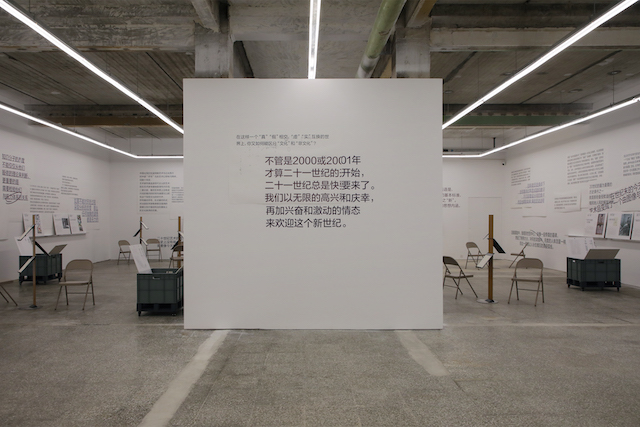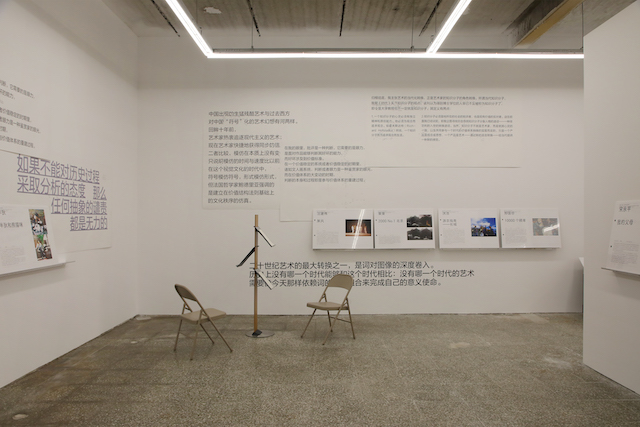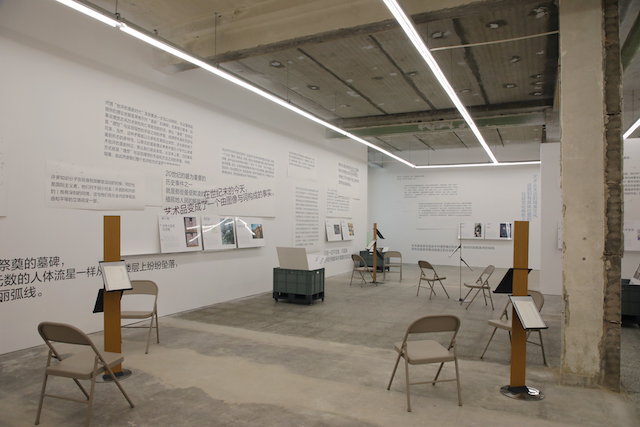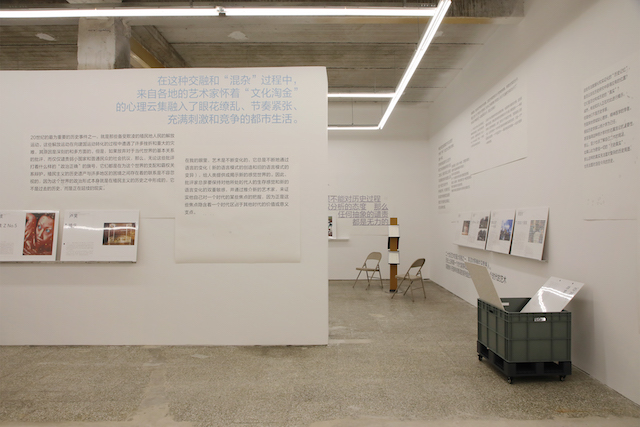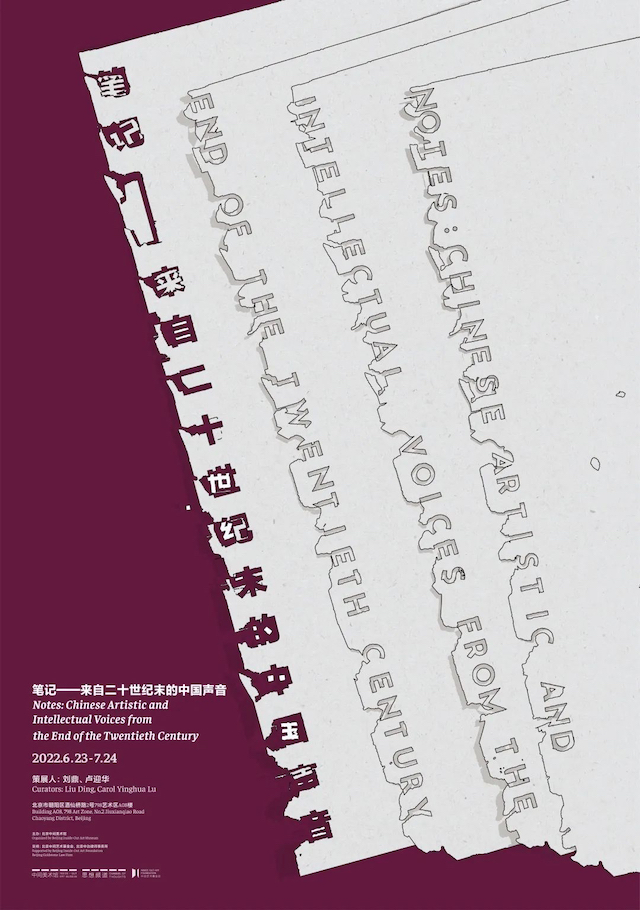
Notes: Chinese Artistic and Intellectual Voices from the End of the Twentieth Century
Jun 23 – Jul 24, 2022
Curators: Liu Ding, Carol Yinghua Lu
Channel of Thoughts By IOAM, Building A08, 798 Art Zone, No.2 Jiuxianqiao Road, Chaoyang District, Beijing
“The 21st century is just around the corner, whether its beginning is in 2000 or 2001. We welcome this new century with infinite joy and jubilation, together with great excitement and thrill.” At the turn of the century, Zhang Kebiao, a notable writer born in 1900, handwrote an essay entitled Welcome to the 21st Century. The centenarian therein reviewed his own experience in China during the 20th century, and looked forward to China’s mission and prospect as a promoter of a universally harmonious world in the global landscape of the 21st century. People at the end of the 20th century were eager to look both backwards and forwards, projecting various individual visions of change and transformation.
The expectations for the future are usually based on the journeys one has made and the experiences one has gained by far. However, even though we are capable of feeling the ups and downs of the present from a current standpoint, it is far from sufficient to perceive and interpret the present from a current perspective. In 2020, we were violently thrown into the third decade of the 21st century by the pandemic. Panic-struck, physically distressed, and mentally confused, we have become prisoners of the present. If we adopt a “COVID calendar,” this year would have already been the third year of the “COVID Era”. Various crises and divisions are still escalating and evolving rather than healing. We have no clue what the world will look like in this new era, at least for the moment. No matter where we turn to, there is not a thing to count on. We have thus developed a desire to investigate further the problems and conditions of the end of the last century from the present, so as to discover critical issues that are relevant to the quest for the zeitgeist of our time. Meanwhile, this revisit will also allow us to re-confront ourselves and the realities. Looking back from our current standpoint, we realize that some of the predictions from the turn of the century have been either verified or falsified. As time goes by, we are gifted with space and opportunities to reflect on what was envisaged and planned for the future in the 20th century.
“Notes: Chinese Artistic and Intellectual Voices from the End of the Twentieth Century” (hereinafter referred to as “Notes”) is a new chapter in the study of the history of Chinese contemporary art in the second half of the 20th century, succeeding our previous exhibition “Waves and Echoes.” By presenting words, notes, images, documents, archives, and works of artists, curators, and scholars, “Notes” surveys the trends of thinking and practices of China’s intellectual and artistic communities at the turn of the century. Upon entering the 1990s, the concepts and imagery of the end of the century and the 21st century made constant appearances in the discourses and creative works of scholars and artists of that time. On one hand, they attempted to break away from the semantic and interpretive system of the 1980s and establish a system of social reality and value that directly addressed and belonged to the 1990s. On the other hand, they perceived the arrival of the turn of the century as a significant point in time that brought them expectations as well as a sense of complexity and sorrow, caused by the shock of the market-oriented economy.
In the exhibition, we have selected essays penned by 18 scholars, curators and artists between 1997 and 2002 and made them into 18 pamphlets for reading. The texts, most of which were published at the time of writing, have appeared in anthologies of collected works, symposium papers, newspapers, journals or personal archives. The authors range from the centenarian Zhang Kebiao to young and middle-aged practitioners in their prime. Their reflections provided multiple perspectives to review and summarize the evolution of thinking and practice in China in the 20th century, especially in its last two decades. Some of them were self-analytical and open-hearted, pointing out the problems of the time straightforwardly; some traced contemporary issues and phenomena back to their historical roots; some were summaries of the past and revelations of the intellectual impetus that inspired the new journey they were about to embark on in the new century. Some of the texts looked back on the 20th century with great affection, but more of them aligned themselves with the century, empirically and emotionally. They understood that they were derived from the century, feeling no need to shy away from the roles they had played in it. Their sincere analysis and sharing provide a number of “original manuscripts” about the 20th century, which are worthy of attention today. We have deliberately juxtaposed texts from the contemporary art world with those from the intellectual community, and have also presented some excerpts from these texts on the walls, forming a field of intellectual voices within the exhibition space.
At the turn of the century, the production of contemporary artworks was inextricably related to the social realities back then, revealing the social space and boundaries of that time. We have sampled works of 43 artists from the late 1990s to the beginning of the 21st century, reproducing these examples in images and textual descriptions. Thus a valuable art historical archive has come into being. In the exhibition, visitors are encouraged to pick them out of cabinets as if they were note cards and to place them on shelves surrounding the walls, where they can be freely juxtaposed and viewed. From today’s perspective, contemporary artists’ practice then was utterly lively and adventurous. Keeping up with their times, they drew keenly on various intellectual sources. Extending the ideological emancipation in the 1980s, the practice of artists was jointly driven by artistic issues and realities of the time. The conceptual practices, which had emerged from the late 1980s, had by this time developed multiple new fields, issues, and means of visual expression, and they were poised to flourish. However, the erosion of humanism by the market-oriented economy and pragmatism, a phenomenon deeply concerned the academic community, would also cast a profound impact on the transformation of the contemporary art scene in China. Such a reality impeded the space for reflection opened up by conceptual art from being further explored in depth and breadth, and leading it gradually to the crisis of self-imposed shackles and rigidity.
With these evidences of thoughts as well as notes, drafts, and artistic materials from the end of the century, we attempt to return to that specific time and space in history, where desire and hope, distress and confidence were germinating. We aim to detect the thinking processes of the protagonists of history at that time, and to critically understand the way they defined themselves and history in the past. Some of them made immediate responses to the realities; some established a relationship with the society through their work; some contemplated the expression of cultural subjectivity in globalization; some reestablished a contemporary foothold by returning to the depths of the discipline and history; some made every aspect of social life the object of cultural criticism, promoting the significance of humanism in the economic society; and some raised numerous expectations for the 21st century. Through these traces of reflection, we witness scholars and artists of the time retrieving, examining, and reassessing the experiences, experiments, emotions, trends, and debates of the 20th century. In this case, this exhibition also becomes a historical “notebook” that documents the existential and creative state of thinkers and practitioners at the turn of the century.
Curators: Liu Ding, Carol Yinghua Lu
Installation Views
View the Exhibition Online
Exhibition Brochure
An electronic version of the exhibition brochure is available for viewing. Click here to download

